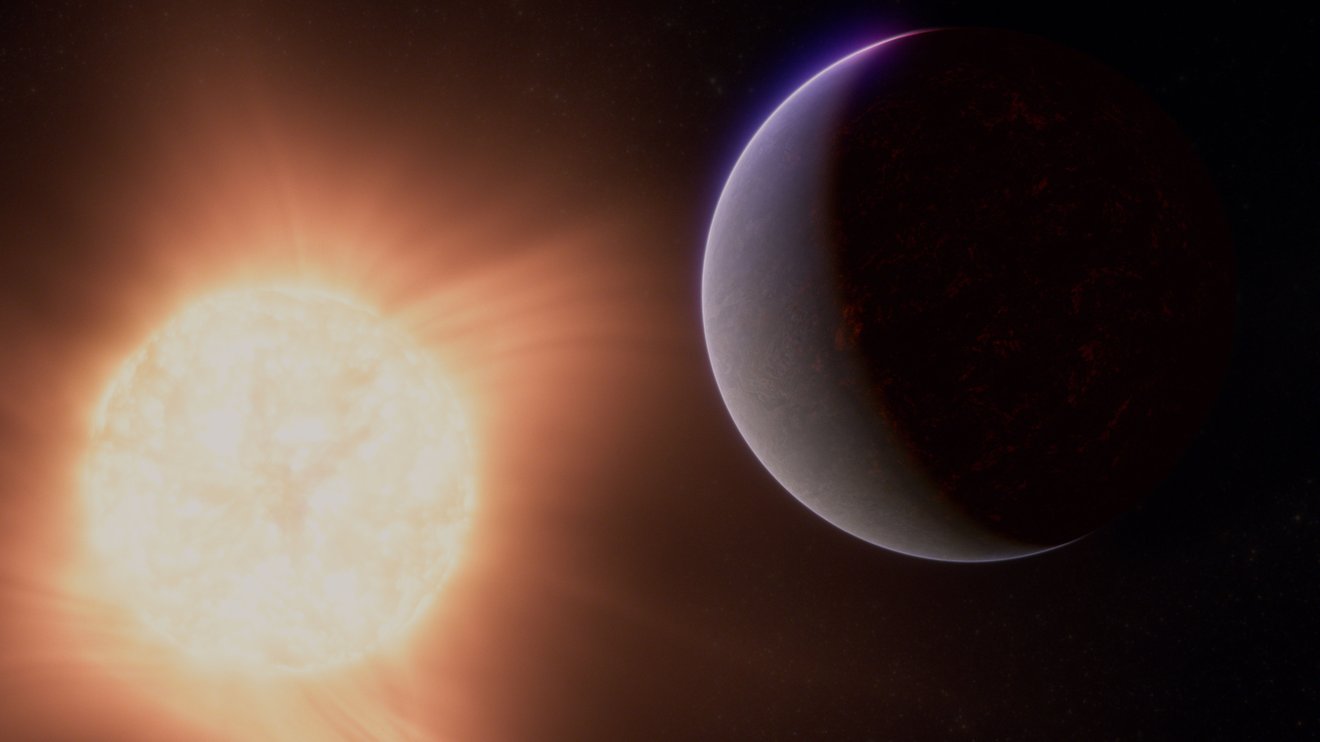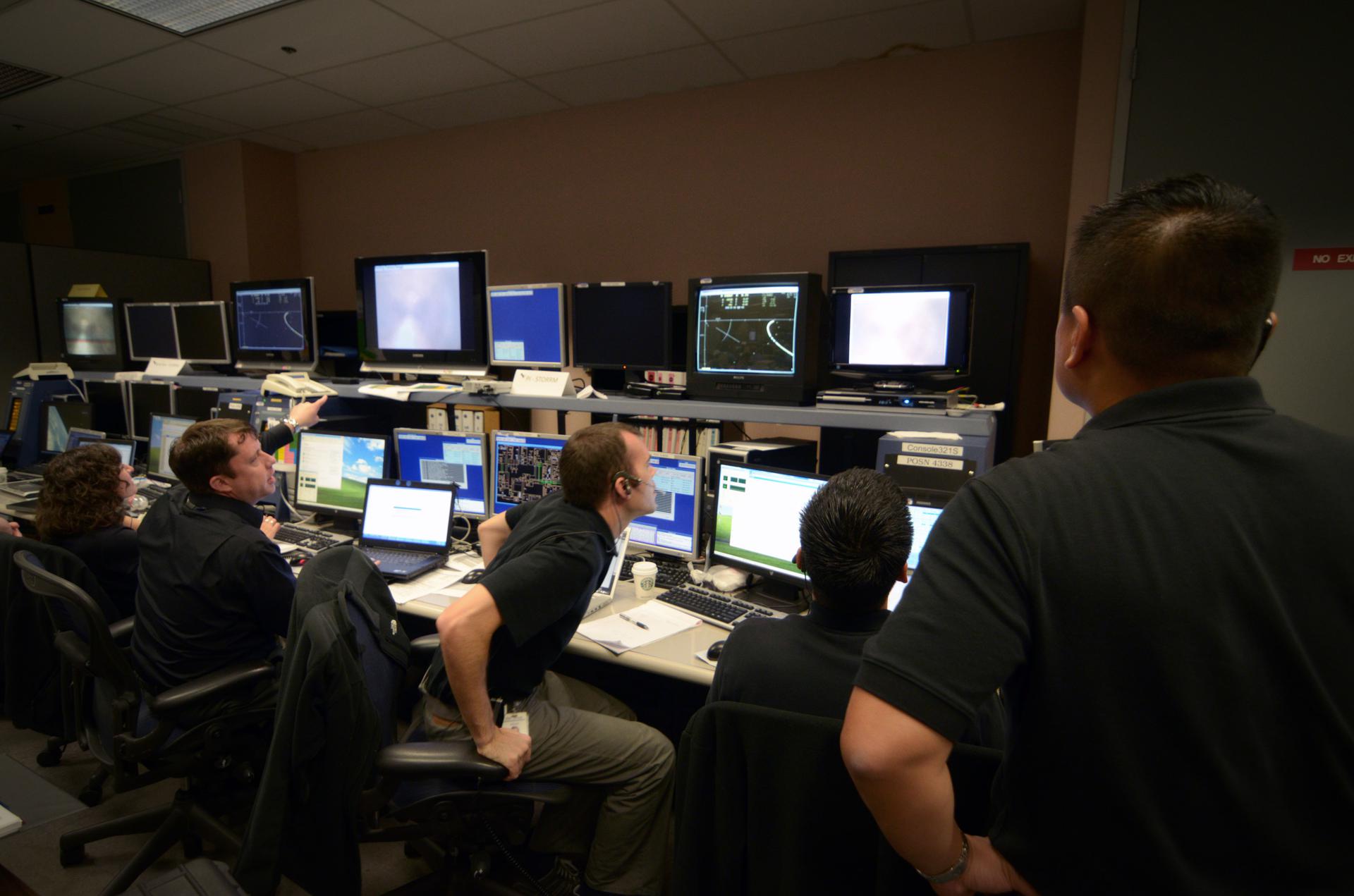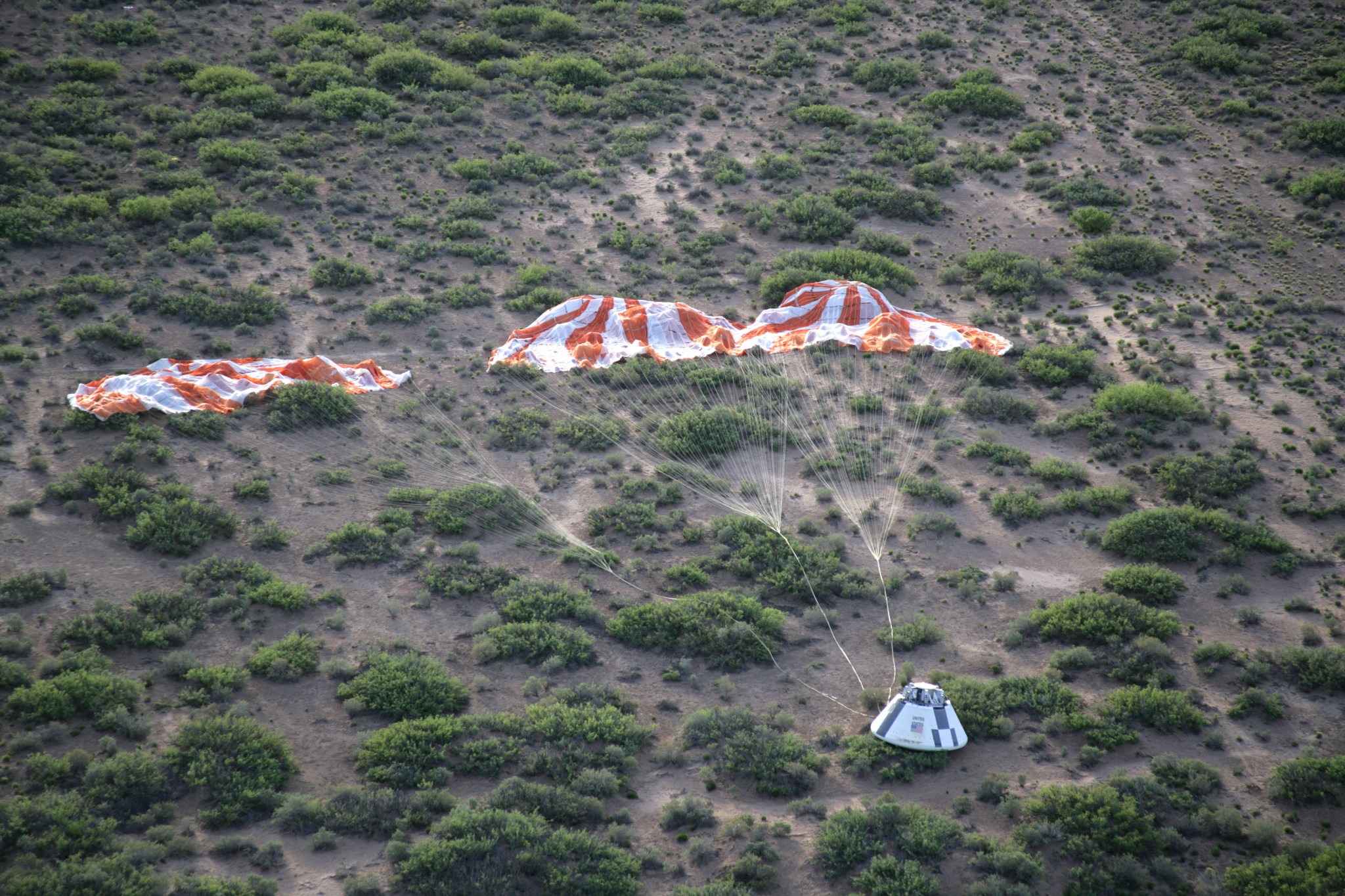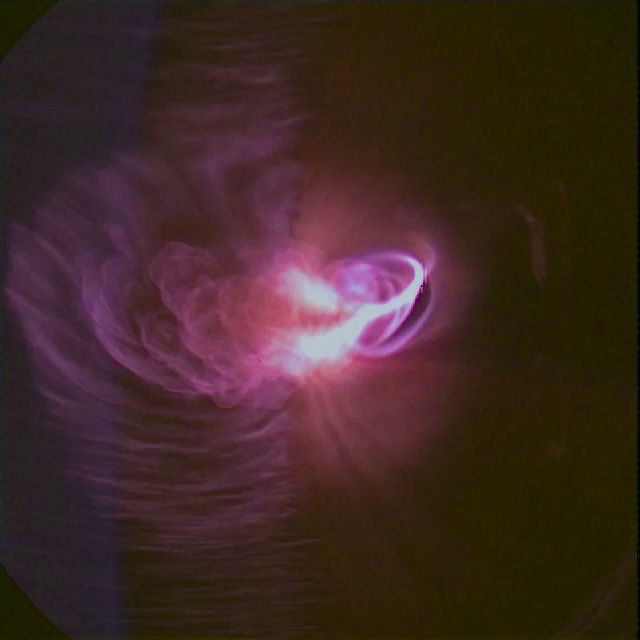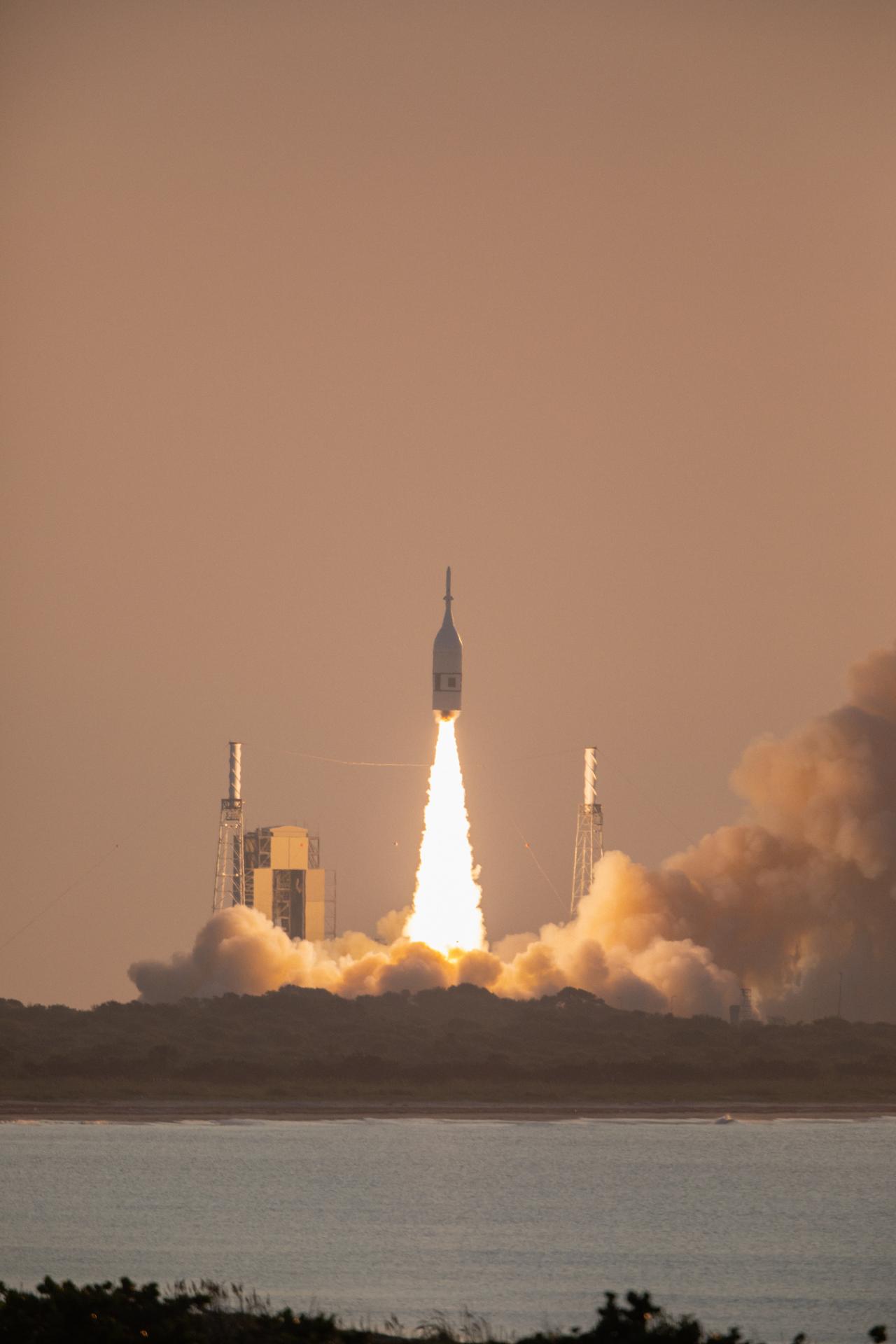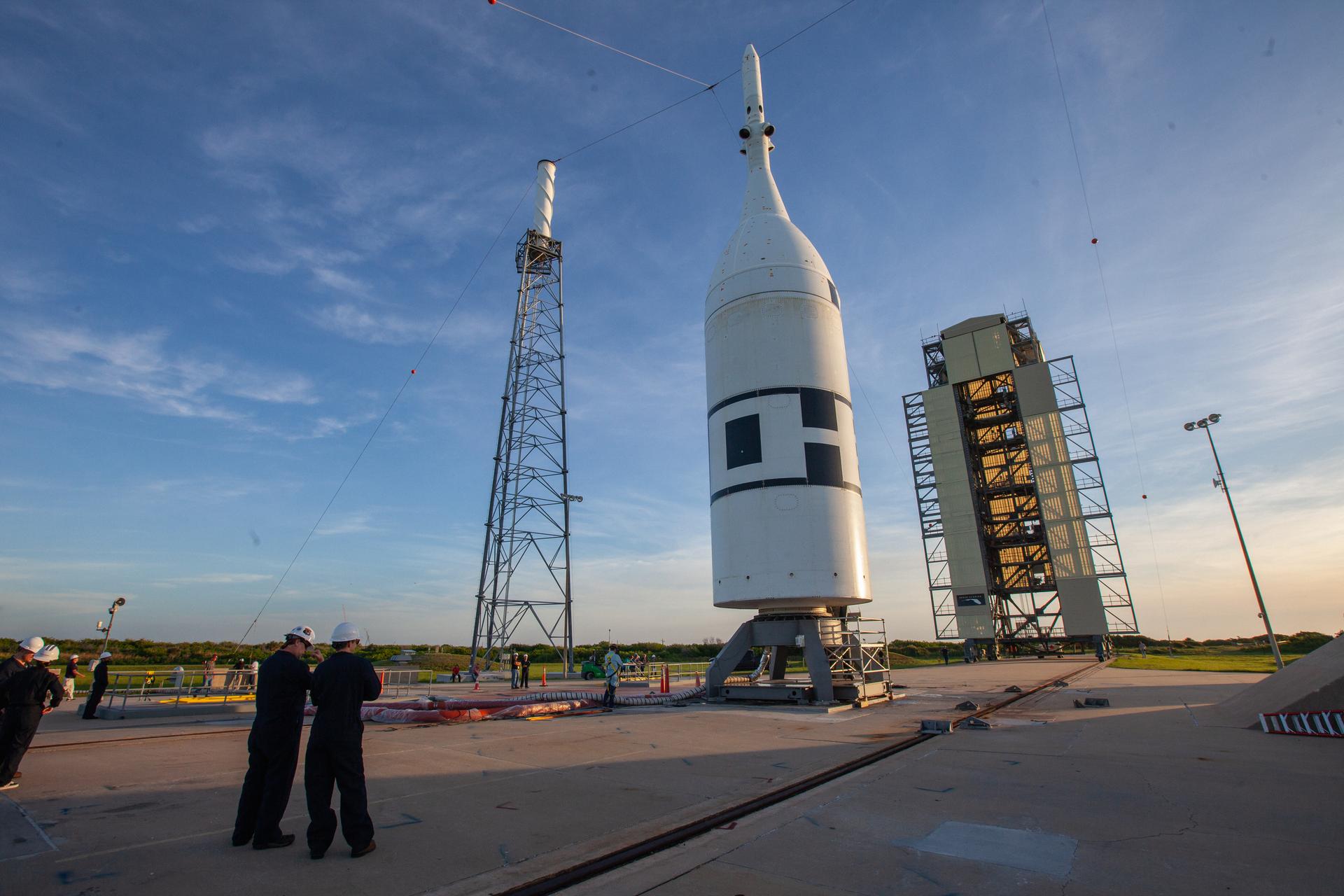Completed Flight Tests

STORRM/STS-134
The Sensor Test for Orion Relative Navigation Risk Mitigation (STORRM) was successfully demonstrated on Space Shuttle Endeavour’s STS-134 mission to the International Space Station (ISS) on May 16, 2011.
The goal of STORRM was to validate a new relative navigation sensor based on advanced laser and detector technology that will make docking and undocking easier and safer, and test the hardware in the same environment that the sensors would experience on the first Orion rendezvous to another vehicle. On Orion, these sensors were installed on the hatch window of the crew module.
Astronauts tested the new navigation and docking system on two different flight days, first on their initial approach to dock to the ISS and later after undocking from the ISS. STS-134 performed an unprecedented re-rendezvous of the ISS, as Commander Mark Kelly and pilot Greg Johnson navigated the shuttle to make an Orion-like approach to the ISS before de-orbiting on Flight Day 14. Astronaut Andrew Feustel operated the STORRM equipment during the testing.
STORRM hardware included a laser-based state-of-the art vision navigation sensor (VNS), which provided an image of the target (in this case, the ISS) and calculated with precise accuracies for range, bearing, alignment and orientation data up to six degrees of freedom. In comparison, the space shuttle’s sensors could only calculate up to three degrees of freedom. The STORRM hardware also included a docking camera to provide high-resolution color imagery. Working together, these sensors provided real-time 3D images with a resolution 16 times higher than previous space shuttle sensors. An avionics assembly, which consisted of a power distribution unit, data recorder unit, and memory storage, was manifested to communicate with a space-certified laptop. Five reflective docking targets were previously installed on the space station during STS-131 and provided a cooperative target for the VNS.
STORRM collected 600 gigabytes of data and the VNS performed better than expected, providing continuous measurements from as far away as 3.5 miles to within six feet of the space station – three times the range capability of the current relative navigation sensor. The sensor technology also provided exceptional 3D images of the target.
The data collected by STORRM will help to make docking and un-docking with other spacecraft safer and easier for astronauts on Orion.
STORRM was developed by the Orion Program at NASA’s Johnson Space Center, which was responsible for program management, technology evaluation, flight test objectives, operational concepts, contract management, and data post-processing.
Engineers at NASA’s Langley Research Center were responsible for engineering management, design and build of the avionics assembly, STORRM software application, and reflective elements. They were also responsible for the integration, testing, and certification of these components. Industry partners Lockheed Martin and Ball Aerospace were responsible for the design, build, and testing of the VNS and docking camera.
| Launch Date | May 16, 2011 8:56 a.m. EDT |
| Landing Date | June 1, 2011 2:34 a.m. EST |
| Launch Site | Kennedy Space Center Launch Complex 39A |
| Launch Vehicle | Space Shuttle Endeavour |
| Landing Site | Kennedy Space Center |
Pad Abort-1
On May 6, 2010, at the U.S. Army’s White Sands Missile Range (WSMR) near Las Cruces, New Mexico, NASA conducted a successful flight test known as Pad Abort-1, a test of the Orion launch abort system (LAS), a critical safety system that sits atop Orion at launch and during ascent. If an emergency occurs during launch, the LAS pulls Orion and its crew away from the rocket for a safe landing in the Atlantic Ocean. Pad Abort-1 demonstrated the capability of the LAS to propel the crew module to a safe distance during a ground-initiated abort on the launch pad. The flight test lasted about 135 seconds from launch until the crew module touched down about a mile north of the launch pad.
The test involved three motors. An abort motor produced a momentary half-million pounds of thrust to propel the crew module away from the pad. It burned for approximately six seconds, with the highest impulse in the first 2.5 seconds. The crew module reached a speed of approximately 445 mph in the first three seconds, with a maximum velocity of 539 mph in its upward trajectory to about 1.2 miles high.
The attitude control motor fired simultaneously with the abort motor and steered the vehicle, using eight thrusters that produce up to 7,000 pounds of thrust. It provided adjustable thrust to keep the crew module on a controlled flight path and reoriented the vehicle as the abort system burned out.
The jettison motor, the only motor of the three that would be used in all nominal rocket launches, pulled the entire launch abort system away from the crew module and cleared the way for parachute deployment and landing. After explosive bolts fired and the jettison motor separated the system from the crew module, the recovery parachute system deployed. The parachutes guided the crew module to touchdown at 16.2 mph (24 feet per second), about one mile from the launch pad.
The Orion Program at NASA’s Johnson Space Center in Houston led the launch abort system test team. NASA’s Langley Research Center designed and built the boilerplate crew module for the test, and NASA’s Dryden Flight Research Center prepared the crew module for integration and led the flight test vehicle integration at WSMR with Lockheed Martin, the prime contractor to NASA for Orion.
| Launch Date | May 6, 2010 7:00 a.m. MDT |
| Launch Site | U.S. Army’s White Sands Missile Range, New Mexico Launch Complex 32E |
| Duration | 2 min., 15 sec. |
| Distance | 6,900 ft. downrange |
| Altitude | 6,336 ft. |
Exploration Flight Test-1
On Dec. 5, 2014, Orion lifted off from Space Launch Complex 37 at Cape Canaveral Air Force Station in Florida on a United Launch Alliance Delta IV Heavy rocket and splashed down approximately 4.5 hours later in the Pacific Ocean. The test, called Exploration Flight Test-1, or EFT-1, demonstrated Orion’s space-worthiness, tested the spacecraft’s heat shield during entry into Earth’s atmosphere, and proved the capsule’s recovery systems. The test flight carried a high-fidelity crew module and a mock service module that remained attached to the rocket’s upper stage until its return to Earth.
At 7:05 a.m., the three-core first stage of the Delta-IV Heavy rocket ignited, lifting Orion off to begin the mission. Approximately four minutes after liftoff, the two side boosters separated as the center core continued firing. The second stage ignited after separation to begin the first of three planned burns. During the first burn, the service module’s protective fairing separated, followed by the launch abort system. This first burn of the second stage placed the spacecraft into a preliminary 115-by-552-mile parking orbit. After completing one revolution around the Earth, during which time controllers in Mission Control in Houston verified the functioning of the spacecraft’s systems, the second stage ignited a second time, raising Orion’s apogee, or high point, above the Earth to 3,600 miles. During the coast to apogee, Orion remained attached to the second stage and completed its first crossing through the inner Van Allen radiation belt.
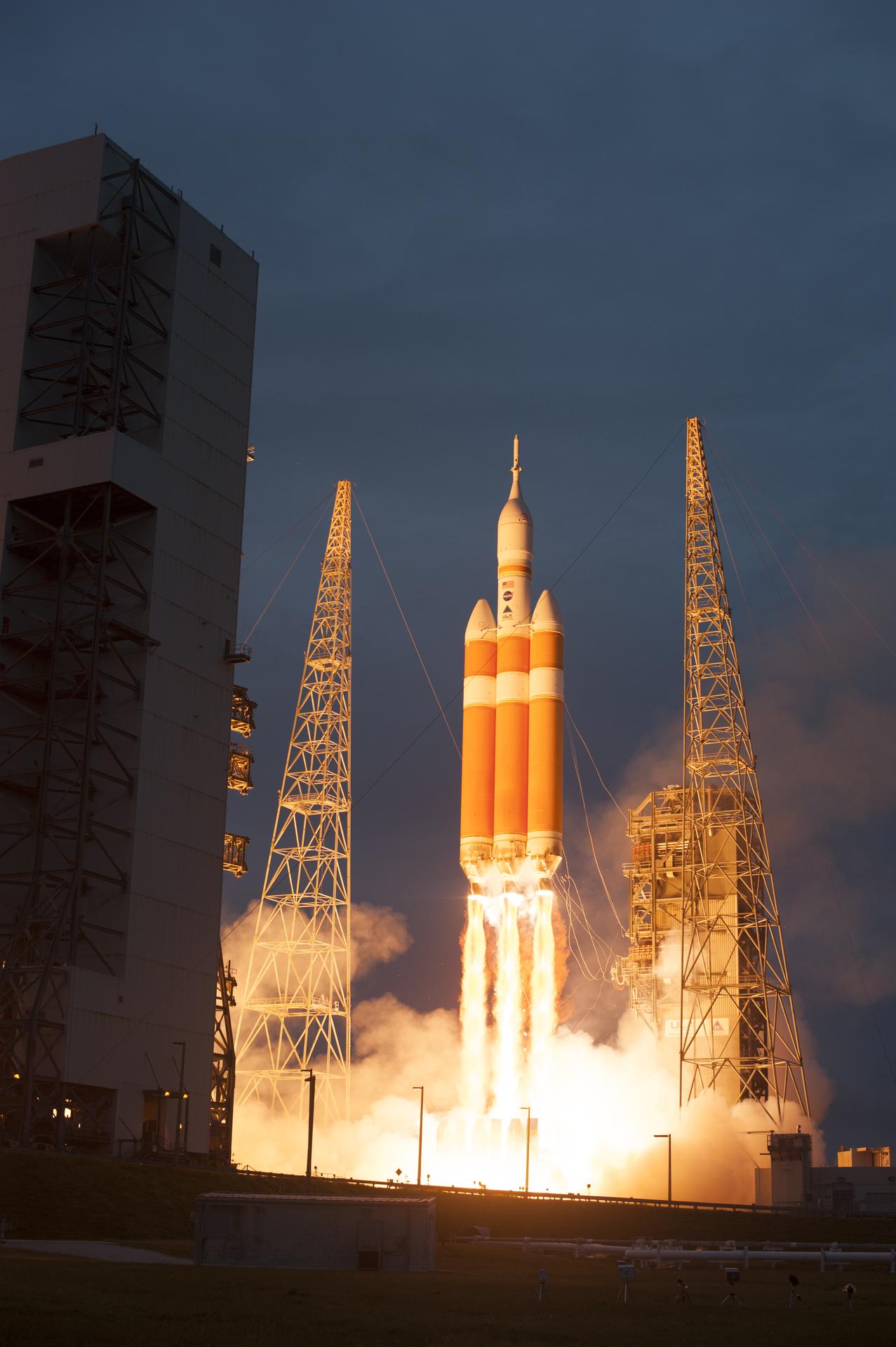
About three hours after launch, Orion reached its apogee and began its descent back toward Earth, separating from the second stage. During the passage back through the Van Allen belt, Orion fired its thrusters to adjust its course for return, and at an altitude of 400,000 feet, the spacecraft entered the Earth’s atmosphere, traveling at 20,000 mph. The spacecraft experienced maximum heating of about 4,000° F, proving the worthiness of the heat shield. After release of Orion’s forward bay cover, two drogue parachutes deployed to slow and stabilize the spacecraft. Then the three main parachutes deployed, slowing the spacecraft to 20 mph. Splashdown occurred 4 hours and 24 minutes after launch about 600 miles southwest of San Diego.
A NASA and U.S. Navy team aboard the USS Anchorage recovered Orion and returned it to U.S. Naval Base San Diego. After its arrival, workers placed the Orion capsule aboard a truck that delivered it to the Kennedy Space Center. After engineers conducted a thorough inspection of the spacecraft at Kennedy, workers trucked it to the Lockheed Martin facility in Littleton, Colorado, where engineers completed final inspections and decontamination of the vehicle, which is now on display at the Kennedy Space Center Visitors Complex.
EFT-1 collected data that is helping NASA lower risks to the astronauts who will later fly on Orion. This included verifying the thermal protection system, hardware separation events, the parachute system and the crew module uprighting system, as well as allowing engineers to identify design issues and fix them before Orion carries astronauts on future missions. The first flight also gave NASA the chance to continue refining its production and coordination processes, and Orion’s design teams gained important experience and training to ensure the industry is prepared to launch Orion on its first integrated flight with the Space Launch System rocket.
Lockheed Martin, NASA’s prime contractor for Orion, manufactured the high-fidelity crew module and a mock service module. The Delta IV Heavy rocket was built by United Launch Alliance. Lockheed Martin began manufacturing the crew module in 2011, and it was constructed at NASA’s Michoud Assembly Facility. Lockheed Martin delivered the crew module in July 2012 to the Neil Armstrong Operations & Checkout Building (O&C) at Kennedy Space Center, where heat shield installation, final assembly, integration and testing were completed. More than 1,000 companies across the country manufactured or contributed elements to Orion for EFT-1.
| Launch Date | Dec. 5, 2014 7:05 a.m. EST |
| Landing Date | Dec. 5, 2014 11:29 a.m. EST |
| Launch Site | Cape Canaveral Air Force Station, Florida, SLC-37B |
| Launch Vehicle | Delta IV Heavy |
| Landing Site | Pacific Ocean, 640 miles SSE off coast of San Diego; Recovered by USS Anchorage |
| Duration | 4 hr., 24 min., 46 sec. |
| Altitude | 3,597.8 miles |
Ascent Abort-2
On July 2, 2019, NASA conducted a successful test known as Ascent Abort-2 (AA-2), which tested the Orion launch abort system (LAS), a critical safety system that sits atop Orion at launch and during ascent. If an emergency occurs during launch, the LAS pulls Orion and its crew away from the rocket for a safe landing in the Atlantic Ocean. Ascent Abort-2 demonstrated this capability of the LAS, propelling the crew module to a safe distance during ascent at a point midway between maximum aerodynamic pressure and maximum aerodynamic drag. This stressing test case, combined with subsystem qualification tests and the successful Pad Abort-1 flight test in 2010, resulted in a LAS that is certified to fly on the Artemis missions with astronauts on board.
During AA-2, a test booster provided by Northrop Grumman launched from Space Launch Complex 46 at Cape Canaveral Air Force Station in Florida at 7 a.m. EDT, carrying a fully functional LAS and a 22,000-pound Orion test vehicle to an altitude of 31,000 feet (approximately six miles) at Mach 1.18 (over 1,000 mph). At that point, the LAS’ powerful reverse-flow abort motor fired 400,000 pounds of thrust, propelling the Orion test vehicle to a safe distance away from the rocket to splashdown in the Atlantic Ocean. The test took approximately three minutes.
A total of 890 developmental flight instrumentation (DFI) measurements were monitored and recorded during AA-2 on the booster, separation ring, crew module, and LAS. During descent, data from the test was downlinked as well as recorded on board by 12 data recorders that were ejected from the crew module in pairs starting 20 seconds after LAS jettison. The foam-encased data recorders initiated tracking beacons upon impact and floated in the ocean, enabling their recovery post-test.
Since AA-2 was meant to test Orion’s ability to abort during ascent, it was not equipped with parachutes nor was the test capsule recovered from the ocean for cost-saving purposes. NASA already fully qualified the parachute system for flights with crew through an extensive series of 17 developmental tests and 8 qualification tests completed at the end of 2018.
NASA’s prime contractor, Lockheed Martin, provided the fully functional Orion LAS, and the crew module to service module umbilical and flight design retention and release mechanisms. NASA’s Johnson Space Center was responsible for producing the fully assembled and integrated crew module and separation ring. This included development of unique avionics, power, guidance, navigation and control (GN&C), software and data collection subsystems, and the ejectable data recorders. Johnson also provided the operations team responsible for conducting the launch, as well as several elements of ground support equipment used to power and control the spacecraft on the launch pad.
The agency’s Langley Research Center built the primary structure of the crew module test article and a separation ring that connected the test capsule to the booster and provided space and volume for separation mechanisms and instrumentation. Critical sensors and instruments used to gather data during the test were provided by NASA’s Armstrong Flight Research Center. Exploration Ground Systems (EGS) and Jacobs Test and Operations Contract (TOSC) processed the vehicle at NASA’s Kennedy Space Center before launch.
| Launch Date | July 2, 2019 7:00 a.m. EDT |
| Launch Site | Cape Canaveral Air Force Station, Florida, SLC-46 |
| Launch Vehicle | Abort Test Booster |
| Duration | 3 min., 13 sec. |
| Altitude | 31,000 ft. (at abort initiation), 55,000 ft. (Orion test vehicle maximum altitude) |




